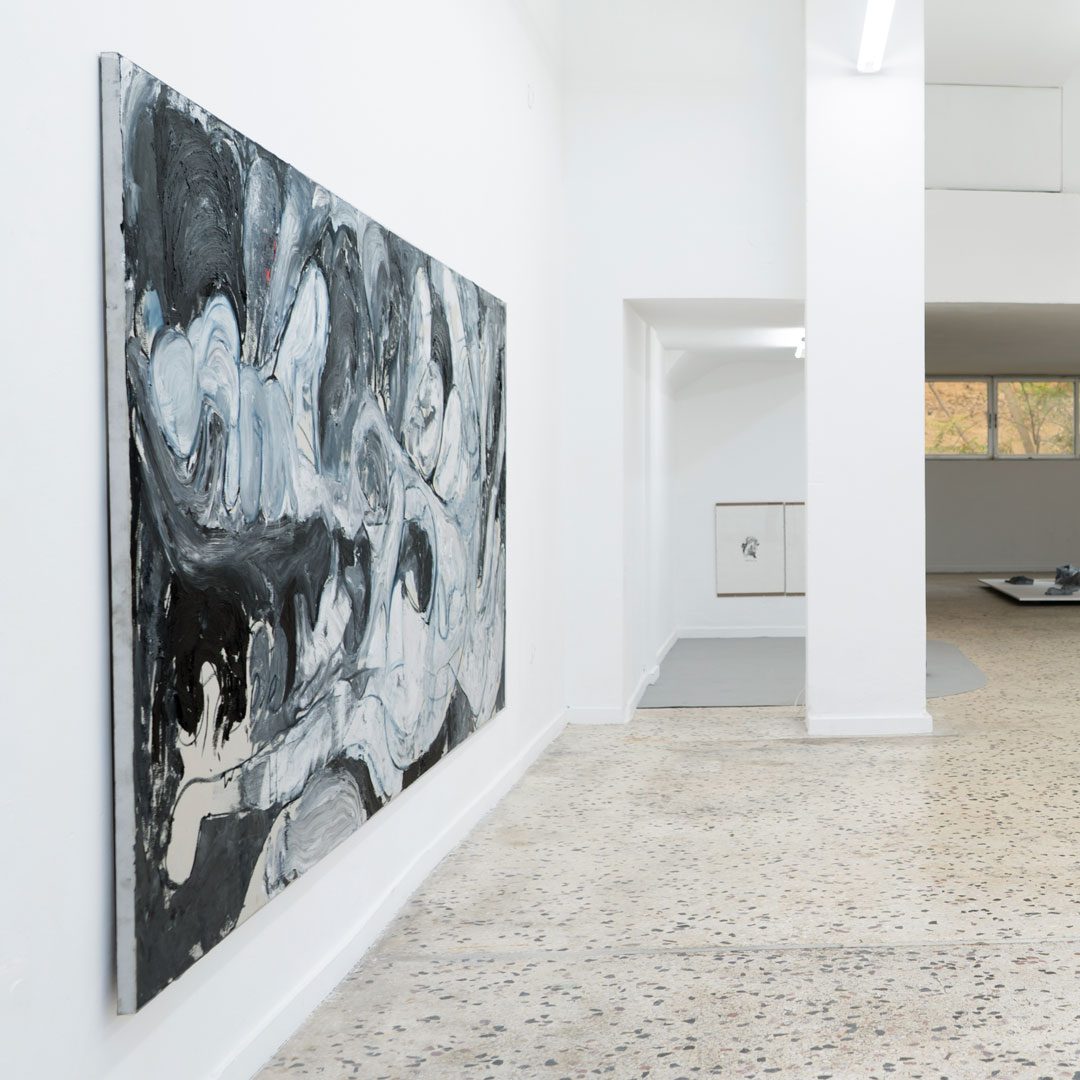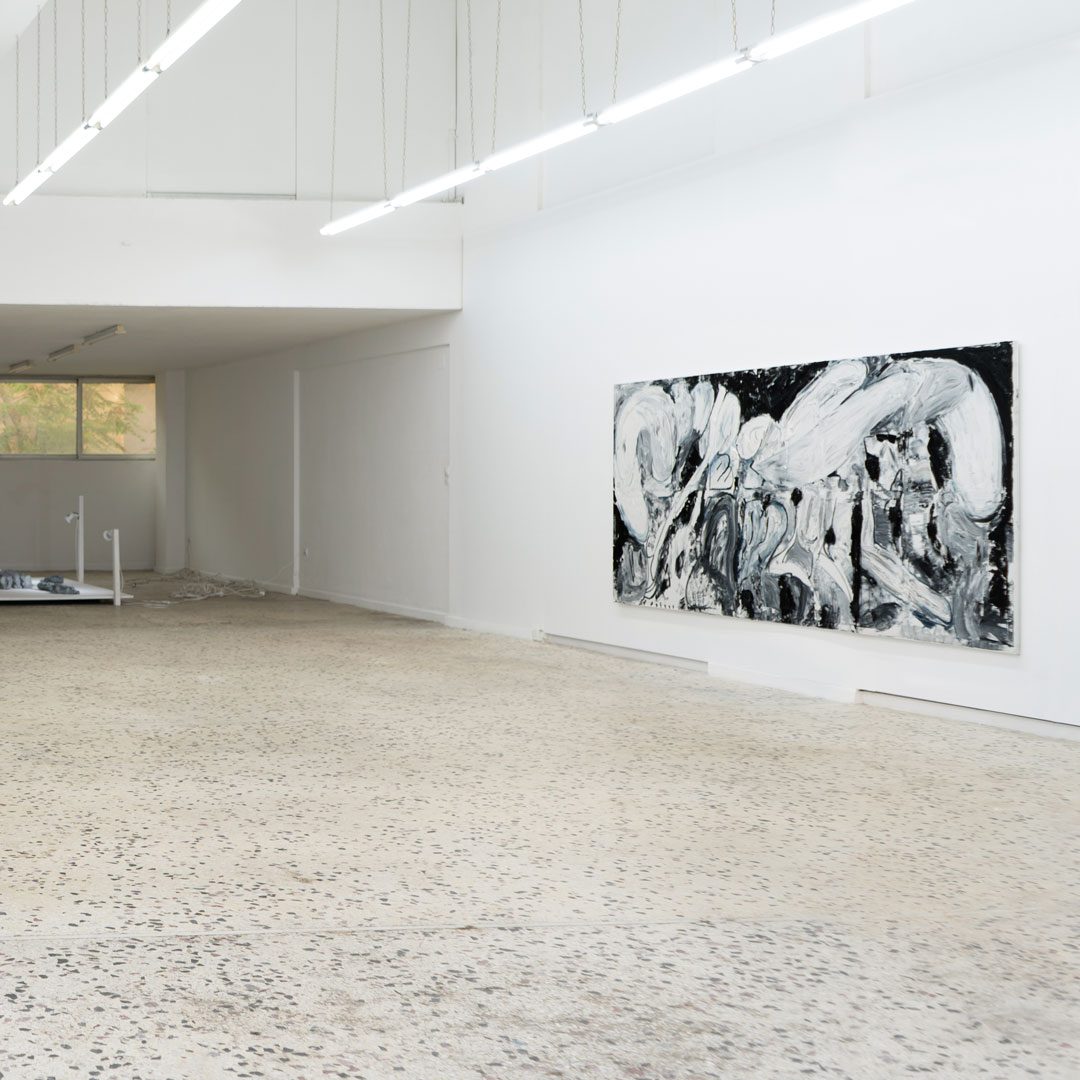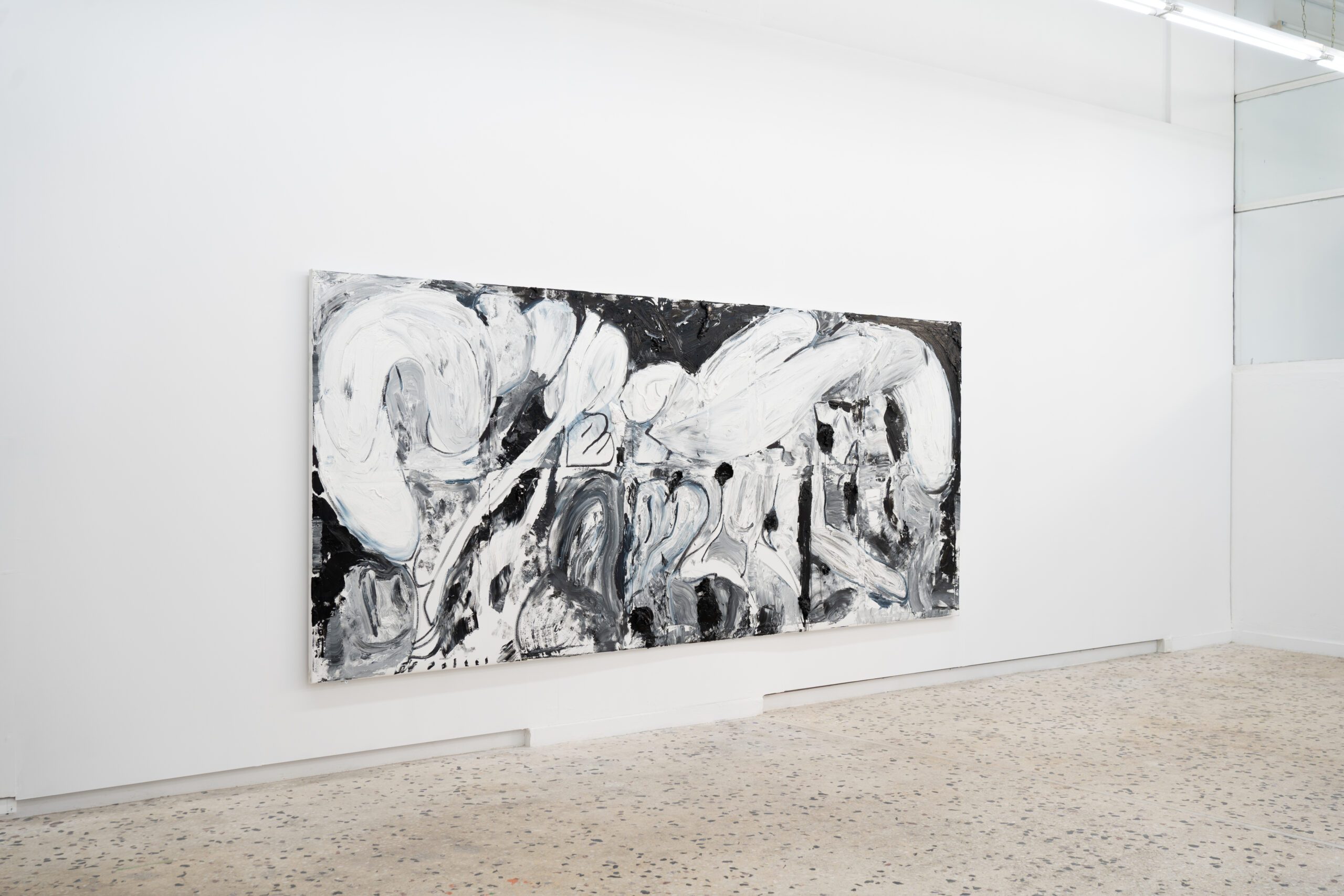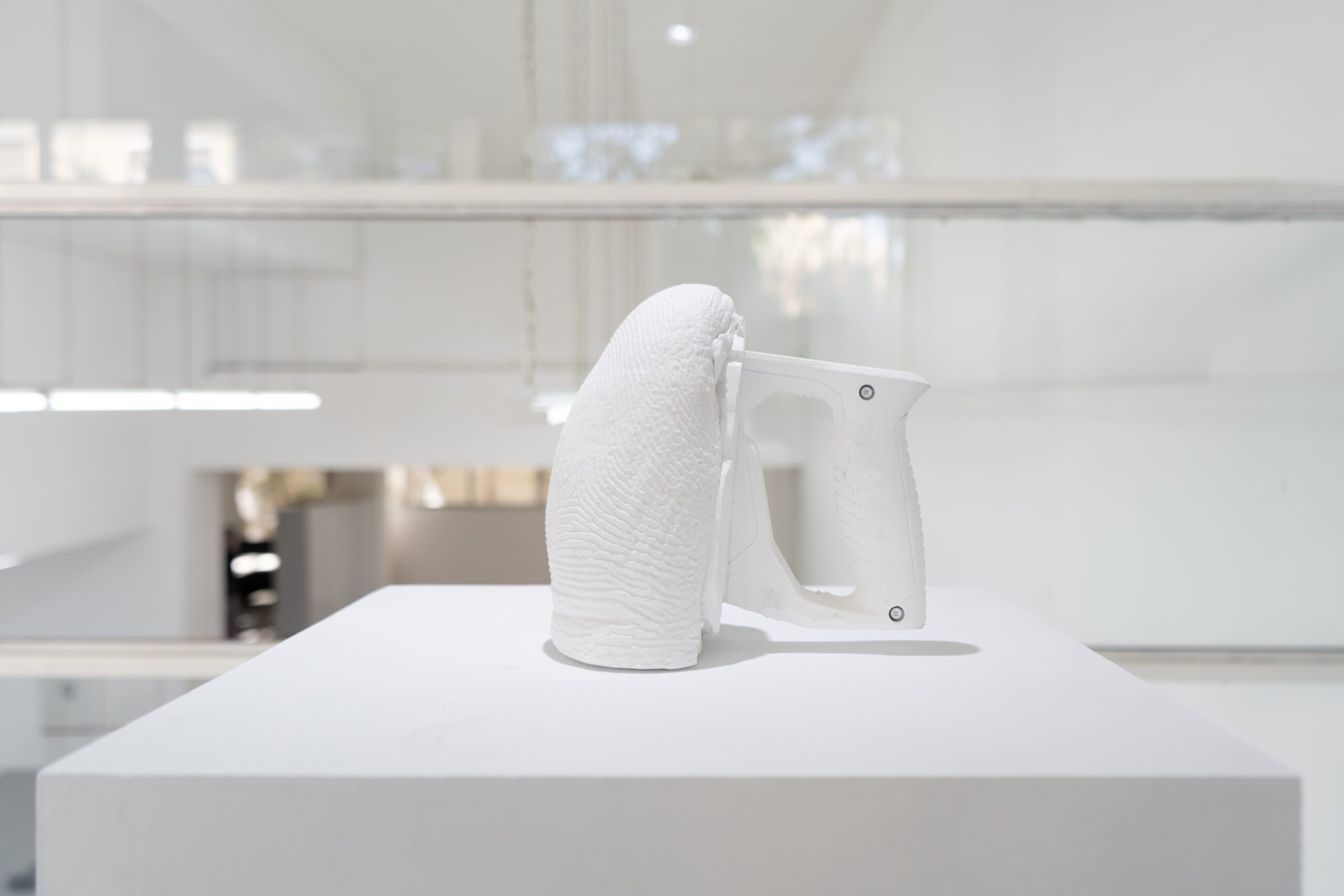Konstantinos Lianos: The Big Smudge
Solo Show by KONSTANTINOS LIANOS
curated by Kostis Stafylakis
October 15-November 05, 2022
pics: Konstantinos Giotis
scroll down for English
The Big Smudge
Κείμενο: Κωστής Σταφυλάκης
Το The Big Smudge είναι μια καλοδιατυπωμένη φάρσα ενάντια στις δοξασίες τις μεταψηφιακής εποχής. Μια μεγεθυμένη, τρισδιάστατα εκτυπωμένη ρέπλικα του δείκτη του χεριού του Κωνσταντίνου Λιανού μουτζουρώνει πίνακες, συνθλίβει τα τμήματα ενός γλυπτού, επιπεδοποιεί αντικείμενα, επιφάνειες, υλικά. Το δαχτυλικό του αποτύπωμα σβήνει μέσα στη μουτζουρωμένη μάζα. Με την απρόσμενη αυτή χειρονομία, Ο Λιανός σαμποτάρει τον εαυτό του, παραμερίζει τον ενθουσιασμό του για τις νέες υλικότητες, τις ανατομίες και τις 3D εκτυπώσεις για να αμφισβητήσει τις προϋποθέσεις της τρέχουσας καλλιτεχνικής δράσης. Το The Big Smudge προσφέρει μια χωροχρονική παρένθεση για να συζητήσουμε τους λόγους για τους οποίους η Τεχνητή Νοημοσύνη, οι έξυπνες τεχνολογίες και άλλες προσβάσιμες τεχνολογίες όπως το photoscan και το 3D printing γίνονται πεισματικά κατανοητές ως διπλασιασμός, προέκταση και προσθετική ενίσχυση της «δημιουργικής αυθεντίας». Στον οριζόντιο κόσμο του The Big Smudge τα υλικά ανθίστανται και τα εργαλεία αποτινάζουν τον ζυγό της προφανούς τους χρήσης.
Ορισμένα ατυχή συμβάντα καθιστούν αναγκαίο αυτό το διάλειμμα ώστε να ξαναρυθμίσουμε μερικά μελλοντολογικά σενάρια. Πρόσφατα, ο σχεδιαστής παιχνιδιών Jason Allen κέρδισε στην ψηφιακή κατηγορία του καλλιτεχνικού διαγωνισμού του Colorado State Fair με ένα AI generated έργο με τίτλο Théâtre D’opéra Spatial. Τρεις εκστατικές φιγούρες που μοιάζουν με τραγουδίστριες όπερας κατοικούν στη μπαρόκ κατασκευή μιας σκηνής που καδράρει ένα φωτεινό κυκλικό άνοιγμα. Είναι μάλλον απρεπές και ανόητο να εφαρμόσουμε αισθητικές κατηγορίες όπως το kitsch για να ασκήσουμε κριτική στο έργο. Θα έπρεπε ίσως να αναγνωρίσουμε τις προκαταλήψεις που διέπουν τη διαμαρτυρία των διαγωνιζόμενων ενάντια στην επιλογή της επιτροπής, διατυπωμένες ως φόβος πως η Τεχνητή Νοημοσύνη θα «αντικαταστήσει» την «ανθρώπινη εργασία και δεξιοτεχνία» της αισθητικής χειροτεχνίας.[i] Ωστόσο, μάλλον οι ίδιες αυτές προκαταλήψεις βράβευσαν το έργο: η οπτική συνάφεια του έργου με μια χειρονακτικά κατασκευασμένη εικόνα από την ιστορία της δυτικής ζωγραφικής – κάποιου είδους AI φωτορεαλισμός. Αυτή η αναμενόμενη εκδίκηση της αναπαραστατικής όρασης έρχεται σε μια εποχή όπου μη-ανθρώπινες ή συνθετικές μορφές νοημοσύνης ξεκινούν να γίνονται αντικείμενο διερεύνησης, αμφισβητώντας το προκείμενο της Τεχνητής Νοημοσύνης.
Σε ένα παρόμοιο συμβάν, ένας εικονικός ράπερ «ακυρώθηκε» από ακτιβιστές. Ο FN Meka λανσαρίστηκε ως χρήστης του TikTok/άβαταρ/ράπερ που υποτίθεται ελέγχεται από μια τεχνητή νοημοσύνη. Δε πήρε χρόνος για τους ερευνητικούς YouTubers να ανακαλύψουν πως ο viral μαύρος ράπερ/άβαταρ του Fortnite δεν ήταν παρά το δημιούργημα ενός μικρού δικτύου λευκών CGI καλλιτεχνών και πως ελάχιστη σχέση είχε με την τεχνολογία της Τεχνητής Νοημοσύνης. Το δίκτυο αυτό καταχράστηκε τη δημοφιλία του όρου Τεχνητή Νοημοσύνη για να πείσει μια δισκογραφική εταιρία να αναλάβει τον FN Meka. Με κάπως τρομακτικό τρόπο, το άβαταρ αυτό επιδείκνυε ένα άφθονο κράμα μαύρης αισθητικής και στιχογραφίας, προκαλώντας ποικίλες φωνές να το καταγγείλουν δημόσια σαν μια σύγχρονη μορφή του blackface. Το μαύρο αυτό ψευδώνυμο, με τα ράστα μαλλιά, τις τρεις χρυσές οδοντοστοιχίες και το προεξέχον χρυσό πηγούνι εγκαταλείφθηκε άμεσα από τη δισκογραφική εταιρία. Το φιάσκο του FN Meka κατέδειξε το πώς μια ρατσιστικά στερεοτυπική πράξη λευκών αποδόθηκε αυθαίρετα στην Τεχνητή Νοημοσύνη. Το περιστατικό αυτό έδειξε επίσης το πώς η εμπορευματοποιημένη AI αισθητική μπορεί συχνά να λειτουργήσει ως προέκταση, βελτίωση, τελειοποίηση και ενίσχυση ενός λευκού, κυρίως ανδρικού, ετεροσεξουαλικού εαυτού.
Για να κανιβαλίσει αυτό το φαλλικό υπόβαθρο της δυτικής καλλιτεχνίας, ο Λιανός καταγίνεται με τη φιλοσοφία του δαχτύλου του δείκτη. Το μεγεθυμένο δάχτυλο εκτίθεται μεγαλειωδώς για να θυμίσει αυτή τη φαλλική ευχαρίστηση. Το δάχτυλο στέκεται γελοία, σε σλάπστικ ντελίριο, στο κέντρο ενός ξεχωριστού εκθετηρίου, ως μια πρησμένη εκδοχή όλων των μεγάλων δαxτύλων-δεικτών της δυτικής εικονοποιίας. Σε μια πράξη αυτό-αποστροφής, ο Λιανός αντιπαραβάλει το πραγματικό του δαχτυλικό αποτύπωμα στο τυπωμένο με τη μεγεθυμένη ρέπλικα. Ο δείκτης είναι σημείο της προστακτικής αλλά και ένδειξη του μεταφυσικού επέκεινα. Ορισμένες διάσημες εικονοποιήσεις περιέχουν τον δείκτη του Πλάτωνα στη Σχολή των Αθηνών του Ραφαήλ, που πιθανώς δείχνει προς τη σφαίρα των ιδεών της θεωρίας των μορφών (ιδεών), πολύ ψηλότερα του υλικού κόσμου. Σκεπτόμενοι την ίδια την πράξη του δεικνύειν, ανθρωπολόγοι και φιλόσοφοι έχουν ανακαλύψει σε αυτή εκείνο που διαφοροποιεί τους ανθρώπους από το υπόλοιπο ζωικό βασίλειο: την ικανότητα της αναφορικότητας. Ο φιλόσοφος και γιατρός Raymond Tallis φτάνει μέχρι το σημείο να προτείνει πως οι δείκτες του Αδάμ και του Θεού στο διάσημο φρέσκο του Μιχαηλαγγέλου θα μπορούσαν να γίνουν εύστοχα κατανοητοί ως σημάδια της πρωτογενούς μας αίσθησης της υπέρβασης.[ii] Λίγα χρόνια πριν τη Γαλλική Επανάσταση, ο Jacques-Louis David θα ζωγραφίσει τον Θάνατο του Σωκράτη. Η φιγούρα του Σωκράτη δείχνει προς τον ουρανό αφιερώνοντας ελάχιστη προσοχή στο κύπελλο με το κώνειο που το άλλο του χέρι απλώνει να πιάσει.
Η ορμή πίσω από τα θραυσματικά χειροτεχνήματα του The Big Smudge αγκαλιάζει την χυδαιότητα που εμφυσά το θεοποιημένο δάχτυλο. Αναιρώντας τη φιλοσοφική ευγένεια του δείκτη, η μεγεθυμένη ρέπλικα περικλείει τη διπλή φύση του μεγάλου δαχτύλου του ποδιού όπως θεωρητικοποιήθηκε από τον Georges Bataille. To Le Gros Orteil(Το μεγάλο Δάχτυλο του Ποδιού), το δημοφιλές κείμενο του Bataille από το περιοδικό Documents 6 (1929), εικονογραφήθηκε με τις μαγευτικές φωτογραφίες του Jacques-André Boiffard που περιείχαν κοντινές λήψεις μεγάλων δαχτύλων του ποδιού να πετάγονται μέσα από το σκοτάδι σαν τερατώδεις οργανισμοί. Το μεγάλο δάχτυλο του ποδιού γίνεται αισθητό σαν το πιο ενοχλητικό και απωθητικό τμήμα του σώματος παρότι χαρακτηρίζεται ως το πιο ανθρώπινο του ανθρώπινου σώματος, υπεύθυνο για τη δυνατότητα της ορθής στάσης που οι άνθρωποι μαθαίνουν να εκτιμούν τόσο πολύ. ‘Η ανθρώπινη ζωή γίνεται λανθασμένα κατανοητή ως ύψωση’, λέει ο Bataille, παραπέμποντας σε μια ιστορική διαδρομή που επιτυγχάνεται μέσω της πολιτισμικής καταπίεσης, του περιορισμού, ακόμα και του βασανισμού του μεγάλου δαχτύλου του ποδιού – αυτού του ενθύμιου της βύθισης στη λάσπη, της σπλαχνικής αναταραχής, που αντιμετωπίζεται με κατεστημένο γέλιο και γελοιοποίηση. Όπως το θέτει ο Bataille, ‘Η αποκρουστικά πτωματική και ταυτόχρονα ηχηρή και περήφανη εμφάνιση του μεγάλου δαχτύλου του ποδιού αντιστοιχεί σε αυτή τη λοιδορία και προσδίδει μια ιδιαίτερα οξεία έκφραση στην αταξία του ανθρώπινου σώματος, στην παραγωγή της βίαιης ασυμφωνίας των οργάνων.’[iii] Τα ευρήματα αυτά ευδοκίμησαν σαν μονοπάτια στις εξερευνήσεις του Bataille σχετικά με το «άμορφο» (L’informe) και τον «χυδαίο υλισμό» (base materialism), εμπνέοντας την Rosalind Krauss και άλλες/ους να αναζητήσουν μια ιστορία του άμορφου – αυτού που καταπιέστηκε και αποβλήθηκε από τις δυτικές επιταγές της φόρμας, της καθετότητας, της δομής, της χρονικότητας.
Ιδωμένο σαν κομμάτι αυτής της ανοικτής αναζήτησης, το The Big Smudge είναι μια άσκηση στην οριζοντιακότητα, στην τήξη ετερογενών ουσιών εντός μιας αποχαρακτηρισμένης συνύπαρξης. Στο The Mosquitoκαι στο Crocodile Lake, ο μεγεθυμένος δείκτης προσποιείται τη βίαιη χειρονομιακότητα της ζωγραφικής του αφηρημένου εξπρεσσιονισμού για να ξανασκεφτούμε την αφαίρεση και τη φόρμα μετά την όραση της Τεχνητής Νοημοσύνης. Η φετιχοποιημένη ιδέα ενός μοναδικού χειρονομιακού αποτυπώματος (συνδεδεμένη με το καθεστώς υπογραφής του χεριού του καλλιτέχνη) ανταλλάζεται με τη διάχυση: η μουτζούρα είναι η πράξη της συγχώνευσης – μια μπασταρδοποίηση των υλικών και των επιφανειών. Η άγρια σαρκικότητα ορισμένων πρόσφατων AI generated εικόνων δεν είναι ούτε πανομοιότυπο του ανθρωπογενούς gore ούτε κάποια σπορά του σουρεαλιστικού «άμορφου» αλλά η απάντηση της μηχανής στις δικές μας ανησυχίες περί «απώλειας» της (σωματικής) ακεραιότητας. Παρόμοια, τα πλεγμένα υλικά της έκθεσης (διαφόρων ειδών υποθετικά ασύμβατοι πηλοί και γύψοι) τεκμηριώνουν την ανάγκη για ένα νέο πλέγμα (mesh). Μέσα στην τραχύτητά της, αυτή η συνάντηση ασύμβατων υλικών, όγκων, και επιφανειών προσφέρει ένα ορισμένο οικοσύστημα – το ειλικρινές πλεόνασμα αυτού του «παιχνιδιού τέλους». Το παραμορφωμένο ανθρωποειδές του The Nudist, με το μισο-ρεαλιστικό κορμό του και το φουσκωμένο κεφάλι και άκρα του, προσφέρουν ένα παρωδιακό απείκασμα του Ανθρώπου του Βιτρούβιου (Κανόνας των Αναλογιών) του Leonardo Da Vinci. Το The Ball και η ρέπλικα του δαχτύλου αποτελούν τόσο ειρωνικές όσο και ειλικρινείς απόπειρες «από-εργαλειοποίησης» – μιας πραγματικής αποειδίκευσης της σχέσης μας με τα αντικείμενα ως «έτοιμα για χρήση». Επιτελούν αυτό το αμφίσημο καθεστώς ανάμεσα στο εργαλείο και το μη-εργαλείο, υπογραμμίζοντας τις αντινομίες της τόσο ανθρώπινης μεταψηφιακότητάς μας.
[i] Για μια αποτίμηση των συμβάντων διαβάστε το Shanti Escalante-De Mattei, AI-Generated Artwork Goes Viral after Winning Award at State Fair, Artnews, September 2022, επισκέψιμο στο https://www.artnews.com/art-news/news/colorado-state-fair-ai-generated-artwork-controversy-1234638022/?fbclid=IwAR3sNEDB-zF1jVCqe1MeBOy359nqJp2E_x7QNnih3rru-GhiaXzsgDMRvcM
[ii] Raymond Tallis, Some points about pointing, Philosophy Now, επισκέψιμο στο https://philosophynow.org/issues/70/Some_Points_About_Pointing
[iii] Georges Bataille, “The Big Toe” (1929). Μετάφραση Allan Stoekl, με τους Carl R. Lovitt και Donald M. Leslie, Jr. Απόσπασμα από το Visions of Excess: Selected Writings, 1927-1939, Minneapolis: UMP, 1985. Επισκέψιμο στο https://supervert.com/translations/georges-bataille/the-big-toe
The Big Smudge
Text by Kostis Stafylakis
The Big Smudge is an eloquently designed farce against the mantras of the post-digital age. A magnified, 3D printed replica of Konstantinos Lianos’s index finger smudges paintings, crushes the parts of a sculpture, and flattens objects, surfaces, and materials. His fingerprint fades into the smudged blob. With this unexpected gesture, Konstantinos Lianos sabotages his own self, sidelines his own fascination with new materialities, anatomies, and 3D prints to challenge the preconditions of today’s artistic agency. The Big Smudge provides a spatiotemporal parenthesis to debate the reasons why Artificial Intelligence, smart technologies, and other accessible technologies such as photoscan or 3D printingare stubbornly understood as duplication, extension, and prosthetic enhancement of “creative authority”. In the horizontal world of The Big Smudge, materials resist, and tools throw off the yoke of their apparent usage.
Some unfortunate events necessitate this intermission to recalibrate certain futurological scenarios. Recently, the game designer Jason Allen won the Colorado State Fair’s art competition in the digital category with an AI-generated work titled Théâtre D’opéra Spatial.Three ecstatic silhouettes, akin to opera singers, inhabit the baroque structure of a stage mounting a bright circular opening. It’s rather inappropriate and senseless to apply aesthetic categories like kitsch to criticize the work. We should rather acknowledge the bias in the contestants’ protest against the committee’s choice, expressed as fear that the AI will “replace” the “human labor and skill” of aesthetic craftsmanship.[i] Yet, it is probably the same bias that awarded the work: the work’s visual kinship to a handcrafted image from the history of western painting – an AI photorealism of a kind. This unsurprising revenge of figurative vision comes at a time when non-human or synthetic forms of intelligence start being addressed, challenging the pretext of Artificial Intelligence.
In a similar incident, a virtual rapper was cancelled by activists. FN Meka, was launched as a TikTok user/avatar/rapper supposedly run by artificial intelligence. It didn’t take time for investigative YouTubers to discover that the viral black rapper/Fortnite avatar was the creation of a small network of white CGI artists, and had little to do with actual AI technology. This network abused the AI catchword to persuade a record company to sign FN Meka in. Alarmingly, the avatar flexed an abundant amalgamation of Black aesthetics and lyrics, probing various voices to call it out as a contemporary blackface. This black moniker, featuring dreadlocks, three rows of golden teeth, and a protuberant golden chin, was rapidly dropped by the record company. The FN Meka fiasco postulated how an act of racist stereotyping by white humans was arbitrarily attributed to an AI. This incident also showcased how commercialized AI aesthetics often play out as extension, improvement, perfection, and enhancement of a white, mostly male, heterosexual self.
To cannibalize this phallic substrate of western artistry, Lianos engages with the philosophy of the index finger. The blown-up finger is majestically displayed to evoke this phallic indulgence. The finger exists laughably, in its slapstick delirium, at the center of its separate showroom, as a swollen version of all the great index fingers featured in western imagery. In a self-loathing act, Lianos juxtaposes his actual fingerprint to the one produced the magnified replica. The index finger is a sign of imperative, but also a marker of the metaphysical beyond. Some famous visualizations include Plato’s index finger in Raphael’s The School of Athens, possibly pointing at the realm of Ideas in his theory of forms, far above our material world. In considering the very act of pointing, anthropologists and philosophers have discovered that which differentiates humans from the rest of the animal kingdom: the capacity to be referential. Philosopher and physician Raymond Tallis goes so far as to suggest that the index fingers of Adam and God in Michelangelo’s famous fresco could be plausibly understood as signs of our primordial sense of transcendence.[ii] A few years prior to the French Revolution, Jacques-Louis David paints The Death of Socrates. The figure of Socrates points to the sky while barely paying attention to the hemlock filled goblet his other hand reaches to grasp.
The impulse behind the crafted fragments of The Big Smudge embraces this baseness instilled by the aggrandized finger. Undoing the philosophical nobility of the pointer, this magnified replica encapsulates the double nature of the big toe as theorized by Georges Bataille. Le Gros Orteil, Bataille’s famous text from Documents 6 (1929),was illustrated with Jacques-André Boiffard’s mesmerizing photographic close-ups of big toes, popping through darkness like beastly organisms. The big toeis felt like the most obtrusive and repulsive body part though delegated as the most human part of the human body, capacitating the erectness humans learn to appreciate so much. ‘Human life is erroneously seen as elevation’, Bataille says, insinuating a historical trajectory achieved through the cultural repression, restriction, even torturing of the toe – this reminder of immersion in the mud, this source of visceral upset, dealt with through habitual laughter and ridicule. As Bataille puts it: ‘The hideously cadaverous and at the same time loud and proud appearance of the big toe corresponds to this derision and gives a very shrill expression to the disorder of the human body, that production of the violent discord of the organs.’[iii] These findings burgeoned as pathways in Bataille’s exploration of “L’informe” and “base materialism”, inspiring Rosalind Krauss and others to search for a history of the formless, of that which was suppressed and expelled by the western precept of form, verticality, structure, and temporality.
Seen as part of this open-ended quest, The Big Smudge is an exercise in horizontality, in congealing heterogeneous substances into declassified coexistence. In The Mosquito and Crocodile Lake, the enlarged pointer fakes the violent gesturality of abstract expressionist painting to rethink abstraction and form after AI vision. The fetishized idea of the unique gestural imprint (associated with the signature status of the artist’s hand) is exchanged with diffusion: the smudge is an act of merging with, a bastardization of materials and surfaces. The wild carnality of some recent AI-generated images is neither a facsimile of human-envisioned gore, nor some spawn of the surrealist “formless” but the machine’s spit-back to our own anxieties over the “loss” of (bodily) integrity. Similarly, the enmeshed materials in the show (various types of purportedly incompatible clay and plaster) testify for the need of a new mesh. In its abruptness, this encounter between incompatible materials, volumes, and surfaces offers a certain ecosystem – the sincere surplus of this endgame. The deranged humanoid of The Nudist, with its quasi-realist torso and its puffed limbs and head, provides a spoofy afterimage of Leonardo Da Vinci’s Vitruvian Man (Canon of Proportions). The Ball and the finger’s replica are both ironic and sincere attempts in “un-tooling” – an actual deskilling of our ready-to-hand relation to objects. They perform that ambiguous state between tool and non-tool, underscoring the antinomies of our all too human post-digitality.
[i] For a take on the case read Shanti Escalante-De Mattei’s, AI-Generated Artwork Goes Viral after Winning Award at State Fair, Artnews, September 2022, accessible at https://www.artnews.com/art-news/news/colorado-state-fair-ai-generated-artwork-controversy-1234638022/?fbclid=IwAR3sNEDB-zF1jVCqe1MeBOy359nqJp2E_x7QNnih3rru-GhiaXzsgDMRvcM
[ii] Raymond Tallis, Some points about pointing, Philosophy Now, available at https://philosophynow.org/issues/70/Some_Points_About_Pointing
[iii]Georges Bataille, “The Big Toe” (1929). Translated by Allan Stoekl, with Carl R. Lovitt and Donald M. Leslie, Jr. Excerpted from Visions of Excess: Selected Writings, 1927-1939, Minneapolis: UMP, 1985. Available at https://supervert.com/translations/georges-bataille/the-big-toe
Konstantinos Lianos (b. 1990 Athens, GR) is a visual artist. He graduated from the Athens School of Fine Arts in 2016. Konstantinos’ work constitutes a conscious experimentation with elements that form the post-digital condition. The way his works are produced often question the digital/material dualism as it focuses on the ways in which the digital dimension structures new materials and vice versa. In 2017 he founded the artist-run space KEIV where he organises and hosts cultural events focusing on the contemporary art scene. He has participated in exhibitions and programmes in Greece and abroad. In 2019 he presented his first solo show Examples of a Manual at GRACE/ATHENS. In 2020 he received the first prize of the annual art competition of Kostas Andreou foundation.
Kostis Stafylakis (b. 1977, Athens, GR) is a visual artist, art theorist and curator with a PhD in political science from Panteion University, Athens. He graduated from the Athens School of Fine Arts and he holds an MA in Art Theory and an MA in Continental Philosophy from the University of Essex. Stafylakis produces art, theory, and curating that respond to social phenomena through the mimetic re-working of social reality. He experiments with how mimetic adaptation can accommodate ambivalence, impurity, and dissent. His recent two-person show is Readiness: Civil War, with Theo Triantafyllidis at Panke Gallery (Berlin, 2022), and his most recent solo show is ‘Chloroquine Juggalo’ at KEIV Athens (2021). His artistic activity includes participations at Prepper Paradise, Bureau Europa, Maastricht (2022), Bless’ed Curse by soloshow.online (2021), Toxicfest at Tick Tack Antwerpen (2021), Enter: New Commissions by Onassis Foundation (2020), Kultursymposium Weimar (2019), the “Festival of Democracy” of Geneva (2017), Waiting for the Barbarians by Athens Biennale (2017), “Omonoia” 5th Athens Biennale (2016), Enjoy your State of Emergency at NGBK, Berlin (2015), 1st NSK Biennial of Folk Art (2014), Hell as Pavillion at Palais de Tokyo (2013), Truth is Concrete by Steirischer Herbst at Graz (2012), Monodrome 3rd Athens Biennale (2011), Media Impact at the 4th Moscow Biennial (2011). He was co-curator of the 6th Athens Biennale ANTI, the 4th Athens Biennale AGORA, Weasel Dance at Goethe-Institut Athen, and more. He has curated various shows, such as “Fuyuhiko Takata” at ViZ Laboratory for Visual Culture and “A politics of lies” at Circuits & Currents (2016). He has published various essays on the junction of contemporary art with the Political, in anthologies and journals. He has been Artistic Director of ViZ Laboratory for Visual Culture. He has taught Research-based Art, art theory and contemporary art at the Athens School of Fine Arts and the University of Patras. He has been a post-doc researcher at ASFA and Aristotle University of Thessaloniki. He currently teaches at the post-graduate program of the Department of Fine and Applied Arts, University of Western Macedonia.



